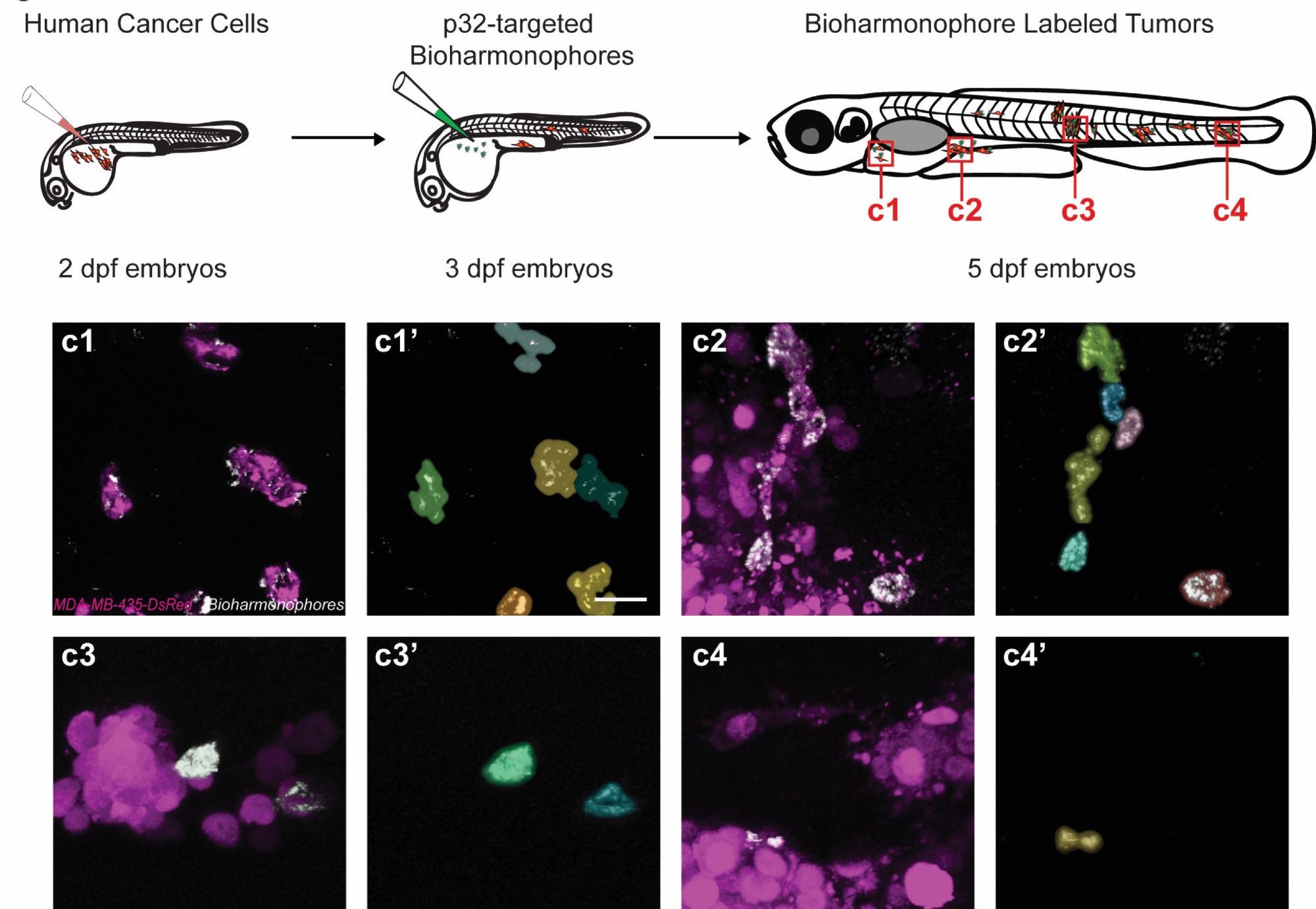Mar 12 2021
New nanoprobes, which were recently developed by Imperial College London (ICL) and tested in zebrafish, could help identify cancer more precisely and may support the diagnosis and treatment in the days to come.
 Purple cancer cells are labeled using bioharmonophores (white label). Image Credit: Imperial College London.
Purple cancer cells are labeled using bioharmonophores (white label). Image Credit: Imperial College London.
To clearly visualize tumors in the body for cancer diagnosis, physicians can utilize miniature optical probes (nanoprobes) that illuminate upon binding to tumors. Such nanoprobes enable doctors to detect the size, shape and location of tumors in the body.
The majority of the nanoprobes are fluorescent, which means they absorb light of a particular color, such as blue, and then produce a background light of a different color, such as green.
But since issues in the human body can also produce light, it can be difficult to differentiate the nanoprobe light from the background light and this could result in wrong interpretation.
Scientists from Imperial College London have now designed new nanoprobes, called bioharmonophores to address this problem. Patented at College London Imperial, the nanoprobes produce light with a new kind of glowing technology, called second harmonic generation (SHG).
The team tested the nanoprobes in zebrafish embryos and discovered that bioharmonophores, which were altered to target tumor cells, emphasized tumors more brightly and for a longer time when compared to the fluorescent nanoprobes.
The light emitted by these bioharmonophores can be easily detected and differentiated by the tissue that generally emits light, and the bioharmonophores also attached accurately to cancer cells and not to the healthy cells, thus making them more accurate in detecting the edges of tumors.
Bioharmonophores could be a more effective way to detect tumours than is currently available. They uniquely combine features that could be great for cancer diagnosis and therapy in clinical practice and could eventually improve patient outcomes following further research.
Dr Periklis Pantazis, Lead Researcher, Department of Bioengineering, Imperial College London
The study results have been published in the ACS Nano journal.
Since bioharmonophores are composed of peptides, they are both biodegradable and biocompatible.
Peptides are the same ingredients of proteins found in the body. These are naturally metabolized in the body in less than 48 hours and are, hence, unlikely to present health threats in the long term.
The team initially injected zebrafish embryos with malignant cancer cells to analyze the accurate detection of tumors. This process enabled the tumor cells to proliferate uncontrollably.
After 24 hours, they again injected bioharmonophores that were altered to target p32 peptide molecules, particularly found in cancer cells.
The researchers subsequently utilized imaging methods at Imperial’s Facility for Imaging by Light Microscopy to study how well the altered bioharmonophores are able to detect the tumors.
The team discovered that bioharmonophores had excellent detection sensitivity, implying they bound to particular tumor cells and not to healthy ones. Fluorescence-enabled nanoprobes are likely to bind less specifically, which means they can misrepresent healthy cells as cancer cells, or the other way round.
The researchers also found that unlike fluorescence, bioharmonophores did not 'bleach,' which means they did not lose their potential to produce light over time.
Besides this, the light produced by bioharmonophores did not saturate as it does with fluorescent nanoprobes. In other words, they become brighter when illuminated with more light. In this manner, tumors became even clearer.
It is very important that tumour nanoprobes highlight cells specifically and clearly for cancer diagnosis. Our proof-of-concept study suggests that the very bright bioharmonophores could be powerful tools in diagnosing cancer and targeting treatments in the coming years.
Dr Periklis Pantazis, Lead Researcher, Department of Bioengineering, Imperial College London
The manufacture of bioharmonophores is scalable, reproducible, and cost-efficient and takes about two days at room temperatures. Currently, bioharmonophores need to be tested in mammals to determine how well these results translate beyond zebrafish.
The team is also exploring ways to apply bioharmonophores to guide surgical interventions at the time of cancer surgery, and how these bioharmonophores could produce light at different frequencies to help destroy cancer cells with high accuracy.
The study was financially supported by the Royal Society, Wellcome Trust, the Swiss National Science Foundation, the European Union, and the Swiss National Centre of Competence in Research.
Journal Reference:
Sonay, A. Y., et al. (2021) Biodegradable Harmonophores for Targeted High-Resolution In Vivo Tumor Imaging. ACS Nano. doi.org/10.1021/acsnano.0c10634.